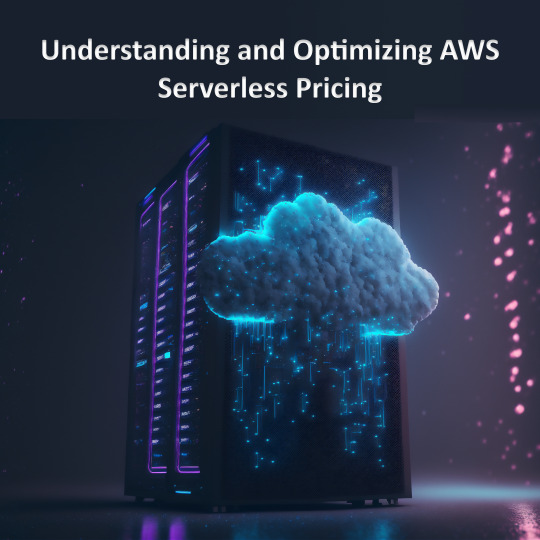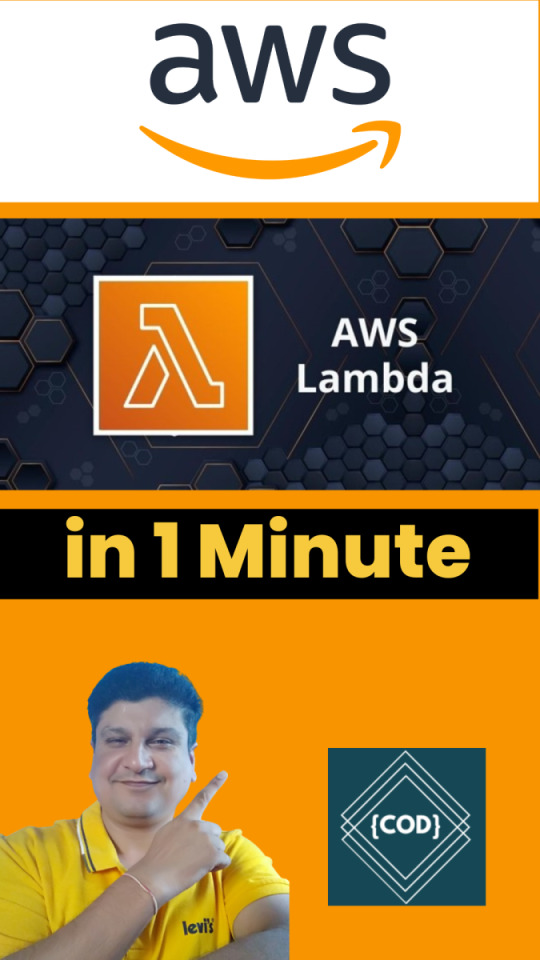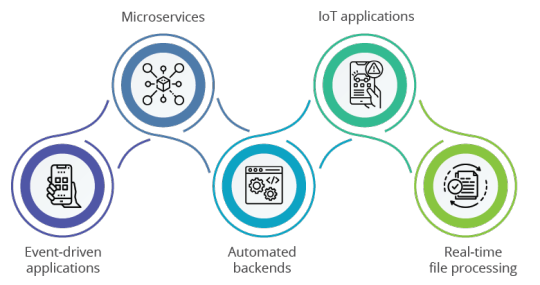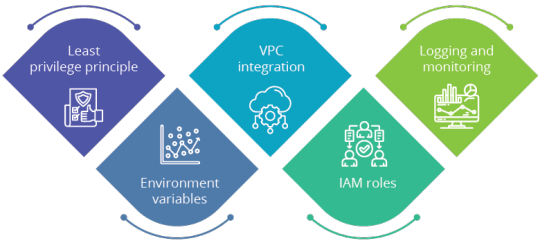#amazon lambda
Explore tagged Tumblr posts
Video
youtube
(via AWS Lambda Compute Service Tutorial for Amazon Cloud Developers) Full Video Link - https://youtube.com/shorts/QmQOWR_aiNIHi, a new #video #tutorial on #aws #lambda #awslambda is published on #codeonedigest #youtube channel. @java @awscloud @AWSCloudIndia @YouTube #youtube @codeonedigest #codeonedigest #aws #amazonwebservices #aws #awscloud #aws #awstutorial #awscloud #awstraining #awslambda #awslambdafunction #awslambdaexample #awslambdajava #awslambdatutorial #awslambdaservice #awslambdaapigateway #awslambdaapigatewaytrigger #awslambdabasic #awslambdaconfiguration #awslambdacode #lambdaservice #amazonlambdajavaexample #awslambdadeveloper #awslambdaeventtrigger #awslambdaeventbridge #awslambdafunctionexample #awslambdaserver #awslambdafunctions3trigger #lambda
1 note
·
View note
Text
#Custom Python Runtime#Streaming with AWS Lambda#Amazon Streaming Services#Serverless Streaming Solutions#Streaming Architecture AWS#Spotify
0 notes
Text
#AWS#AWS Step Functions#Step Functions#AWS CodePipeline#CodePipeline#Amazon EventBridge#EventBridge#Approval Flow#Approval Action#AWS CloudFormation#CloudFormation#AWS Lambda#Lambda#CI/CD#DevOps
0 notes
Text
Explore the best practices for using AWS Lambda, including where to use it, security implications, performance optimization, and cost management tips. Learn how to leverage serverless computing effectively for scalable and secure applications.
0 notes
Text
Understanding and Optimizing AWS Serverless Pricing

In today's fast-paced digital landscape, agility and scalability are paramount for businesses to thrive. AWS Serverless offers a solution to this demand by allowing developers to build and deploy applications without managing servers. However, while serverless computing brings numerous benefits, understanding its pricing structure is crucial to avoid unexpected costs. This article delves into AWS Serverless pricing, exploring its services, pricing models, factors influencing costs, and best practices for cost efficiency.
AWS Serverless Services and Their Pricing Models
AWS offers a suite of serverless services designed to streamline application development and deployment. Key services include AWS Lambda, Amazon API Gateway, AWS Step Functions, Amazon DynamoDB, and AWS Fargate. Each service operates on a different pricing model tailored to its specific functionalities.
AWS Lambda
AWS Lambda stands out as a widely embraced compute service within the Amazon Web Services (AWS) ecosystem, offering developers the ability to execute code without the complexities associated with server provisioning and management. At its core, AWS Lambda simplifies the process of deploying and scaling applications by allowing users to focus solely on writing code, while AWS handles the underlying infrastructure.
When it comes to pricing, AWS Lambda operates on a straightforward model primarily centered around two key metrics: the number of requests (or invocations) and the duration of code execution. Notably, AWS provides users with a generous free tier, granting the first one million requests per month at no cost. Beyond this allocation, users incur a nominal charge of $0.20 per additional one million requests, ensuring cost-effective scalability for applications experiencing higher demand. Understanding how to choose the billing model for your Lambda function is crucial for optimizing costs and ensuring efficient resource allocation.
AWS Step Functions
AWS Step Functions, a serverless workflow service offered by AWS, facilitates microservices coordination through visual workflows. Its pricing model revolves around state transitions, where each execution of a workflow step counts as a transition. Users receive 4,000 complimentary state transitions monthly, after that incurring a charge of $0.025 per 1,000 transitions. Complex workflows with extensive state transitions can lead to rapid cost accumulation. Hence, optimizing workflows becomes crucial for the effective management of Step Function expenses.
Amazon API Gateway
Amazon API Gateway, a fully managed service by AWS, simplifies API management for developers, offering creation, publishing, maintenance, monitoring, and security features at any scale. Its pricing structure primarily hinges on two factors: the number of API calls received and data transfer out. API Gateway supports two main types of APIs: RESTful and WebSocket. For RESTful APIs, users are charged $3.50 per million API calls, while WebSocket APIs incur a charge of $1.00 per million messages along with $0.25 per 1 million connection minutes. Additional data transfer costs vary based on the region and the volume of data transferred.
Factors Affecting Serverless Function Cost
While AWS Serverless offers a cost-effective solution for application development, several factors influence the overall cost of running serverless functions. Understanding these factors is crucial for effective cost management and optimization. Here are some key factors to consider:
Invocation Frequency: The number of times a serverless function is invoked directly impacts its cost. Each invocation incurs charges, making it essential to monitor and manage invocation frequency. Applications with high user activity or continuous execution may experience increased costs, necessitating optimization strategies to control expenses.
Execution Duration: The duration of code execution directly affects the cost of serverless functions. AWS Lambda charges users based on the duration their code executes, rounded up to the nearest 100 milliseconds. Longer execution times result in higher costs, highlighting the importance of optimizing code performance to reduce execution duration and associated expenses.
Memory Allocation: AWS Lambda allows users to specify the amount of memory allocated to serverless functions. The chosen memory size impacts performance and cost, as AWS charges based on the allocated memory. Optimizing memory allocation based on workload requirements can help minimize costs while ensuring optimal function performance.
External Dependencies: The usage of external services or resources within serverless functions can incur additional charges. Integration with AWS services or external APIs may involve data transfer costs, particularly if data is transferred out of AWS regions. Minimizing external dependencies and leveraging services within the same region can help mitigate data transfer expenses.
Scaling Behavior: Automatic scaling of serverless resources can lead to cost fluctuations, especially during peak periods. Applications experiencing sudden spikes in traffic may incur higher costs due to increased resource utilization. Implementing concurrency limits and utilization controls can help manage scaling behavior and prevent unexpected cost escalations.
Monitoring and Optimization: Regular monitoring and optimization are essential for managing serverless function costs effectively. Monitoring performance metrics, analyzing usage patterns, and identifying optimization opportunities can help reduce unnecessary resource consumption and control expenses over time.
Best Practices for Serverless Cost Efficiency
As businesses increasingly adopt serverless computing for application development, optimizing cost efficiency becomes paramount to maximize the value derived from AWS Serverless services. In addition to understanding pricing structures and service offerings, implementing best practices for serverless development is essential. Best Practices for Serverless Development offers valuable insights into design principles, security measures, performance optimization, and scalability strategies. Here are some best practices to ensure cost-effective operation:

Right-Size Your Functions: Utilize the AWS Lambda Pricing Calculator to estimate costs and right-size your functions. Choose an appropriate memory size based on workload requirements to balance performance and cost. Regularly review and adjust memory sizes to optimize resource utilization.
Minimize Execution Time: Optimize code efficiency to minimize the duration of code execution. Refactor code for performance, avoid unnecessary operations, and leverage concurrent executions to process multiple requests simultaneously. Implement provisioned concurrency to eliminate Lambda cold starts and ensure consistent performance.
Implement Throttling: Set concurrency limits for Lambda functions to prevent unexpected spikes in usage and control costs. Adjust concurrency limits based on usage patterns and performance metrics to optimize resource allocation and prevent throttling errors.
Utilize Reserved Concurrency: Reserve concurrency for critical functions to ensure consistent performance and cost predictability. Allocate reserved concurrency based on application requirements and usage patterns to optimize resource allocation and prevent over-provisioning.
Monitor and Analyze Usage: Utilize AWS CloudWatch to monitor performance metrics, analyze usage patterns, and identify optimization opportunities. Set up alerts for abnormal behavior and adjust resource allocation accordingly to optimize cost efficiency.
Optimize Data Transfer: Minimize data transfer costs by optimizing API usage and leveraging services within the same AWS region. Implement caching mechanisms to reduce the frequency of data transfers and optimize data transfer efficiency.
Implement Cost Controls: Set budget limits, utilization alerts, and usage quotas to prevent unexpected cost overruns. Implement resource tagging and cost allocation to track spending and identify areas for optimization.
Regularly Review and Optimize: Conduct regular reviews of serverless architecture, performance metrics, and cost reports to identify optimization opportunities. Continuously optimize resource allocation, code efficiency, and usage patterns to ensure cost efficiency over time.
By implementing these best practices, businesses can optimize the cost efficiency of their serverless architecture and maximize the value derived from AWS Serverless services. Proactive cost management strategies, combined with efficient resource utilization and continuous optimization, ensure that serverless computing remains a cost-effective solution for modern application development.
Conclusion
In conclusion, navigating the cost of AWS Serverless requires a comprehensive understanding of its pricing structure, service offerings, and factors influencing costs. By embracing best practices for cost efficiency, businesses can harness the full potential of AWS Serverless services while mitigating unexpected expenses. From right-sizing functions and minimizing execution time to implementing throttling and utilizing reserved concurrency, proactive cost management strategies ensure optimal resource utilization. Regular monitoring, analysis, and optimization further contribute to long-term cost efficiency and value realization. With a strategic approach to cost management, businesses can confidently leverage AWS Serverless to drive innovation and scalability in today's dynamic digital landscape.
0 notes
Video
youtube
Lambda Lab | Start and Stop EC2 Instances using Lambda Function | Tech A...
0 notes
Text
🫀cover reveal🫀
Oh no! My bookshelf fell over and the cover for That Devil, Ambition was revealed!

It's here! The cover for my next standalone young adult fantasy - That Devil, Ambition - from HarperCollins is here, and it's gorgeous!
I have been obsessed with this cover since the original concept crossed my desk. It's foreboding, moody, and a little suspicious. I feel so lucky to have the team at Harper in my corner for this ambitious book.
From Fabian (my boy! it's my terrible boy!) peering through the stacks to the cracked glasses, there's just so much on this cover that makes me smile. It's perfect.
I hope y'all love it as much as I do and go look at Colin's other work. He's done some of my favorite covers.
cover artist: Colin Verdi cover designer: Julia Tyler
goodreads
amazon
bookpeople
barnes & noble
kobo audiobook
From Lambda Literary Award finalist Linsey Miller comes this thrilling stand-alone fantasy about the lengths we'll go to get ahead—an incredibly fresh, twisty love letter to dark academia...with a body count. Perfect for fans of A Study in Drowning by Ava Reid, Gallant by V. E. Schwab, and All of Us Villains by Amanda Foody and C. L. Herman. There is only one school worth graduating from, and it creates as many magicians as it does graves… First in his class and last in his noble line, Fabian Galloway’s only hope of a good future is passing his elite school's honors class. It’s only offered to the best thirteen students, and those students have a single assignment: kill their professor. If they succeed, their student debt is forgiven. However, if an assassination attempt fails or the professor is alive at the end of the year, the students’ lives are forfeit. And dealing with the professor, a devil summoned solely to kill or be killed, is no easy task. Fabian isn't worried, though. He trusts his best friends—softhearted math genius Credence and absent-minded but insightful Euphemia—to help. After all, that’s why he befriended them. As the months pass and their professor remains impossibly alive, the trio must use every asset they have to survive. Or else failure will be on their academic records—and their tombstones—forever.
#that devil ambition#personal writing things#dark academia#young adult fantasy books#idk y'all it's a book about 3 friends who think they could solve the trolley problem#also the devil is fake dating the librarian#it's a whole thing
24 notes
·
View notes
Text
tuesday again 5/21/2024
get a load of this cat

listening
one of my favorite bands, Joywave, dropped a new album last week! it is not my favorite album of theirs but so it goes. perhaps it needs more time to grow on me. Sleepytime Fantasy kicks off my favorite section of the album. video game enchanted ice cave dream sequence music.
youtube
i must stay true to my own rules for this series (not a rec series, genuinely what i've been into the most this week) and the song that's been on loop all week is a genshin impact character's theme music (punchy wolf-coded ice cop who is the duke of the prison he. runs? administers? don't worry about it). unfortunately a bop. the character music lately has been a lot more modern and experimental than i expected? this one has a police siren drop
youtube
-
reading
thank you mackintosh.



i really, really enjoyed Trouble And Her Friends by Melissa Scott (LAMBDA award winner 1995)! @delta-orionis and i frequently ask ourselves "what if neuromancer was good?" and this scratches that itch for me. it is often difficult for me to take neuromancer's protagonist henry seriously, but this book features a pair of extremely practical dykes. it opens on the passing of a new american law criminalizing big swathes of online activity, passed despite a presidential veto. description from amazon
Less than a hundred years from now, the forces of law and order crack down on the world of the computer nets. The hip, noir adventurers who get by on wit, bravado, and drugs, and haunt the virtual worlds of the Shadows of cyberspace, are up against the encroachments of civilization. It's time to adapt or die. India Carless, alias Trouble, got out ahead of the feds and settled down to run a small network for an artist's co-op. Now someone has taken her name and begun to use it for criminal hacking. So Trouble returns. Once the fastest gun on the electronic frontier, she had tried to retire-but has been called out for one last fight. And it's a killer.
this startled me by how fun and competent it is! i tried reading one of the author's books last year (Dreamships) and had a miserable time with the pacing and flow of information. there are echoes of the pacing issues i had with the last book-- this is a nearly four hundred page hardcover, we have a lot of Next Locations to go to, and we are going to take our fucking time getting there. a road trip book, rather than a destination book. Scott has gotten way way better at fleshing out those locations— an artists' co-op has their skylights set to amber to hide the wear and tear on everything in their central hangout space when the feds show up. i also connected with the inciting incident way more-- someone stealing a female hacker’s name and style is instantly relatable. i am riding shotgun with Trouble. i am ready to throw down with her.
it's a very physical book in many ways, bc it has three brief sex scenes, is very concerned with sensuality in both senses of the word, and overall it's like the background in an anime that’s full of dials and buttons and little blinky lights. written in 1994, fascjnating how much concepts of VR and sensory inputs have not changed, but everyone still has the equivalent of an enormous old school desktop and giant CRT monitors set up. everyone is constantly lugging around so much physical tech. the stuff that makes you better at hacking in the net is quick reactions to VR sensations, the only way to get that cutting edge sensation is to get a physical chip or “worm” in your head, and the only people who do that are the core outcasts and freaks of the internet (the gays, the women, the people of color, the all three, presumably the furries as well). from that day to this…
there's an interesting contrast between Trouble and her old partner Cerise stalking the virtual reality bazaars/being queens of the BBS undergrounds, and the danger they feel and face when moving about in the real world. some reviewers are very cranky about how negotiations on and offline feel the same but i did not feel this particular quibble. communication is communication. it is known both on and offline that they're 1) women and 2) lesbians. they're in less physical danger online but slurs can still happen no matter where they are. also, i am well used to the necessity of having to posture and peacock and be kind of a bitch to establish myself in order to get anything done in coding/hardware scenes, which is something i don't think any of the male reviewers of the day ever had to think about.
some cowboy shit goes down at the end that had me hooting and hollering, and Scott handled the hacking scenes in an interesting way-- a sort of abstracted duel? terrific "fight" scenes. very interesting at how she will move things around in order to treat scenes in ways she's good at-- like establishing very grounded locations that feel real, physical sensations, and fight scenes-- instead of just kind of slogging through a very surface level high-overview travelogue like in her last book. ive been stuck on a fic chapter for like four years and this is making me think about doing it the fun way instead of the way i thought it should be done. this may be obvious but i am an amateur and more importantly an idiot.
this was a $6/1 book special last year at one of my favorite thrift stores, a religious shop with the absolute worst vibes in the greater houston area but some of the best stuff
-
watching
Five Dolls For An August Moon (1970, dir. Brava). sometimes you see a cool title on kanopy and you don't have a better way to kill an hour and a half. plus it had some guys i know from cowboys. tw for a suicide's body in the first fucking ten seconds of the trailer, which is a weird trailer choice bc u don't actually see most of the murders in the movie.
ive watched a fuck of a lot of spaghetti westerns so i feel i am somewhat qualified to tell you this is one of the worst dubs ive ever seen. the lines actors are quarter-heartedly delivering do not always make a lot of sense and only occasionally match the subtitles. i am assuming this is the original dub, bc kino lorber generally does a pretty okay job restoring things?
youtube
this is not a good movie (extremely troubled production, director swap three days before filming, made on a shoestring budget, the actors mostly wore their own clothes, etc). it is not very good at maintaining tension, because it is a film that first and foremost Looks. beautiful fucking sets, beautifully decorated. the exterior is a matte painting, a sort of frothy dream-bubble of sixties architecture. most of the interiors are apparently a real house. incredible experimental burbling soundtrack full of Weird Sounds.

sorry about the tubi interface and our old friend the activate windows logo.
there are so many fun directorial flourishes and staging, but it does get a little wrapped up in itself. this made me think of The Secret of NIMH, a beautifully animated talking-animal film that gave me nightmares as a child, where the animation tricks and sparkles and moving parts sort of all get in each other's way to produce something less than the sum of its parts. this sort of happens here. i'm going to yoink this from a review:
Bava’s eye for exquisite compositions is equally evident. One scene in particular stands out in this regard: The filmmaker shoots an otherwise humdrum fistfight through wooden latticework that breaks the action up into an abstracted mosaic effect. The fight culminates with a table being upended, which in turn unleashes a myriad crystal spheres. The camera follows along as the spheres tumble and cascade down a spiral staircase and roll across a tiled floor before plopping like so many bath bubbles into a tub. The scene concludes with the revelation of a recently deceased character caught in what you’d have to call a tableau morte. It’s a dazzlingly orchestrated sequence, easily on par with more famous Bava set pieces.
it's gorgeous! there's also So Much going on. another lovely bit of business: as each person dies they get wrapped in plastic sheeting and put in the walkin freezer. next to slabs of beef. not a subtle film, and i don't mean it as a diss, bc where's the fuckin fun in that?
-
playing
i have not been doing much of anything here except listen to podcasts and work toward the two-thousand-fish-caught achievement in genshin. impatiently waiting for Clorinde to be released in several weeks. that one button needs a raise. it is So funny to see genshin characters with fucking guns. very sword and pike based societies so far

-
making
every time i have tried to make one of these samplers for Me it's gone horribly wrong or been somehow destroyed so i'm making this one for my brother's upcoming birthday, bc he will have off-campus housing next academic year, in an attempt to peacefully do some fucking cross stitch and get something out at the end of it. pattern here on etsy

45 notes
·
View notes
Text
AWS Lambda Compute Service Tutorial for Amazon Cloud Developers
Full Video Link - https://youtube.com/shorts/QmQOWR_aiNI Hi, a new #video #tutorial on #aws #lambda #awslambda is published on #codeonedigest #youtube channel. @java @awscloud @AWSCloudIndia @YouTube #youtube @codeonedigest #codeonedigest #aws #amaz
AWS Lambda is a serverless compute service that runs your code in response to events and automatically manages the underlying compute resources for you. These events may include changes in state such as a user placing an item in a shopping cart on an ecommerce website. AWS Lambda automatically runs code in response to multiple events, such as HTTP requests via Amazon API Gateway, modifications…

View On WordPress
#amazon lambda java example#aws#aws cloud#aws lambda#aws lambda api gateway#aws lambda api gateway trigger#aws lambda basic#aws lambda code#aws lambda configuration#aws lambda developer#aws lambda event trigger#aws lambda eventbridge#aws lambda example#aws lambda function#aws lambda function example#aws lambda function s3 trigger#aws lambda java#aws lambda server#aws lambda service#aws lambda tutorial#aws training#aws tutorial#lambda service
0 notes
Text
Transforming LLM Performance: How AWS’s Automated Evaluation Framework Leads the Way
New Post has been published on https://thedigitalinsider.com/transforming-llm-performance-how-awss-automated-evaluation-framework-leads-the-way/
Transforming LLM Performance: How AWS’s Automated Evaluation Framework Leads the Way


Large Language Models (LLMs) are quickly transforming the domain of Artificial Intelligence (AI), driving innovations from customer service chatbots to advanced content generation tools. As these models grow in size and complexity, it becomes more challenging to ensure their outputs are always accurate, fair, and relevant.
To address this issue, AWS’s Automated Evaluation Framework offers a powerful solution. It uses automation and advanced metrics to provide scalable, efficient, and precise evaluations of LLM performance. By streamlining the evaluation process, AWS helps organizations monitor and improve their AI systems at scale, setting a new standard for reliability and trust in generative AI applications.
Why LLM Evaluation Matters
LLMs have shown their value in many industries, performing tasks such as answering questions and generating human-like text. However, the complexity of these models brings challenges like hallucinations, bias, and inconsistencies in their outputs. Hallucinations happen when the model generates responses that seem factual but are not accurate. Bias occurs when the model produces outputs that favor certain groups or ideas over others. These issues are especially concerning in fields like healthcare, finance, and legal services, where errors or biased results can have serious consequences.
It is essential to evaluate LLMs properly to identify and fix these issues, ensuring that the models provide trustworthy results. However, traditional evaluation methods, such as human assessments or basic automated metrics, have limitations. Human evaluations are thorough but are often time-consuming, expensive, and can be affected by individual biases. On the other hand, automated metrics are quicker but may not catch all the subtle errors that could affect the model’s performance.
For these reasons, a more advanced and scalable solution is necessary to address these challenges. AWS’s Automated Evaluation Framework provides the perfect solution. It automates the evaluation process, offering real-time assessments of model outputs, identifying issues like hallucinations or bias, and ensuring that models work within ethical standards.
AWS’s Automated Evaluation Framework: An Overview
AWS’s Automated Evaluation Framework is specifically designed to simplify and speed up the evaluation of LLMs. It offers a scalable, flexible, and cost-effective solution for businesses using generative AI. The framework integrates several core AWS services, including Amazon Bedrock, AWS Lambda, SageMaker, and CloudWatch, to create a modular, end-to-end evaluation pipeline. This setup supports both real-time and batch assessments, making it suitable for a wide range of use cases.
Key Components and Capabilities
Amazon Bedrock Model Evaluation
At the foundation of this framework is Amazon Bedrock, which offers pre-trained models and powerful evaluation tools. Bedrock enables businesses to assess LLM outputs based on various metrics such as accuracy, relevance, and safety without the need for custom testing systems. The framework supports both automatic evaluations and human-in-the-loop assessments, providing flexibility for different business applications.
LLM-as-a-Judge (LLMaaJ) Technology
A key feature of the AWS framework is LLM-as-a-Judge (LLMaaJ), which uses advanced LLMs to evaluate the outputs of other models. By mimicking human judgment, this technology dramatically reduces evaluation time and costs, up to 98% compared to traditional methods, while ensuring high consistency and quality. LLMaaJ evaluates models on metrics like correctness, faithfulness, user experience, instruction compliance, and safety. It integrates effectively with Amazon Bedrock, making it easy to apply to both custom and pre-trained models.
Customizable Evaluation Metrics
Another prominent feature is the framework’s ability to implement customizable evaluation metrics. Businesses can tailor the evaluation process to their specific needs, whether it is focused on safety, fairness, or domain-specific accuracy. This customization ensures that companies can meet their unique performance goals and regulatory standards.
Architecture and Workflow
The architecture of AWS’s evaluation framework is modular and scalable, allowing organizations to integrate it easily into their existing AI/ML workflows. This modularity ensures that each component of the system can be adjusted independently as requirements evolve, providing flexibility for businesses at any scale.
Data Ingestion and Preparation
The evaluation process begins with data ingestion, where datasets are gathered, cleaned, and prepared for evaluation. AWS tools such as Amazon S3 are used for secure storage, and AWS Glue can be employed for preprocessing the data. The datasets are then converted into compatible formats (e.g., JSONL) for efficient processing during the evaluation phase.
Compute Resources
The framework uses AWS’s scalable compute services, including Lambda (for short, event-driven tasks), SageMaker (for large and complex computations), and ECS (for containerized workloads). These services ensure that evaluations can be processed efficiently, whether the task is small or large. The system also uses parallel processing where possible, speeding up the evaluation process and making it suitable for enterprise-level model assessments.
Evaluation Engine
The evaluation engine is a key component of the framework. It automatically tests models against predefined or custom metrics, processes the evaluation data, and generates detailed reports. This engine is highly configurable, allowing businesses to add new evaluation metrics or frameworks as needed.
Real-Time Monitoring and Reporting
The integration with CloudWatch ensures that evaluations are continuously monitored in real-time. Performance dashboards, along with automated alerts, provide businesses with the ability to track model performance and take immediate action if necessary. Detailed reports, including aggregate metrics and individual response insights, are generated to support expert analysis and inform actionable improvements.
How AWS’s Framework Enhances LLM Performance
AWS’s Automated Evaluation Framework offers several features that significantly improve the performance and reliability of LLMs. These capabilities help businesses ensure their models deliver accurate, consistent, and safe outputs while also optimizing resources and reducing costs.
Automated Intelligent Evaluation
One of the significant benefits of AWS’s framework is its ability to automate the evaluation process. Traditional LLM testing methods are time-consuming and prone to human error. AWS automates this process, saving both time and money. By evaluating models in real-time, the framework immediately identifies any issues in the model’s outputs, allowing developers to act quickly. Additionally, the ability to run evaluations across multiple models at once helps businesses assess performance without straining resources.
Comprehensive Metric Categories
The AWS framework evaluates models using a variety of metrics, ensuring a thorough assessment of performance. These metrics cover more than just basic accuracy and include:
Accuracy: Verifies that the model’s outputs match expected results.
Coherence: Assesses how logically consistent the generated text is.
Instruction Compliance: Checks how well the model follows given instructions.
Safety: Measures whether the model’s outputs are free from harmful content, like misinformation or hate speech.
In addition to these, AWS incorporates responsible AI metrics to address critical issues such as hallucination detection, which identifies incorrect or fabricated information, and harmfulness, which flags potentially offensive or harmful outputs. These additional metrics are essential for ensuring models meet ethical standards and are safe for use, especially in sensitive applications.
Continuous Monitoring and Optimization
Another essential feature of AWS’s framework is its support for continuous monitoring. This enables businesses to keep their models updated as new data or tasks arise. The system allows for regular evaluations, providing real-time feedback on the model’s performance. This continuous loop of feedback helps businesses address issues quickly and ensures their LLMs maintain high performance over time.
Real-World Impact: How AWS’s Framework Transforms LLM Performance
AWS’s Automated Evaluation Framework is not just a theoretical tool; it has been successfully implemented in real-world scenarios, showcasing its ability to scale, enhance model performance, and ensure ethical standards in AI deployments.
Scalability, Efficiency, and Adaptability
One of the major strengths of AWS’s framework is its ability to efficiently scale as the size and complexity of LLMs grow. The framework employs AWS serverless services, such as AWS Step Functions, Lambda, and Amazon Bedrock, to automate and scale evaluation workflows dynamically. This reduces manual intervention and ensures that resources are used efficiently, making it practical to assess LLMs at a production scale. Whether businesses are testing a single model or managing multiple models in production, the framework is adaptable, meeting both small-scale and enterprise-level requirements.
By automating the evaluation process and utilizing modular components, AWS’s framework ensures seamless integration into existing AI/ML pipelines with minimal disruption. This flexibility helps businesses scale their AI initiatives and continuously optimize their models while maintaining high standards of performance, quality, and efficiency.
Quality and Trust
A core advantage of AWS’s framework is its focus on maintaining quality and trust in AI deployments. By integrating responsible AI metrics such as accuracy, fairness, and safety, the system ensures that models meet high ethical standards. Automated evaluation, combined with human-in-the-loop validation, helps businesses monitor their LLMs for reliability, relevance, and safety. This comprehensive approach to evaluation ensures that LLMs can be trusted to deliver accurate and ethical outputs, building confidence among users and stakeholders.
Successful Real-World Applications
Amazon Q Business
AWS’s evaluation framework has been applied to Amazon Q Business, a managed Retrieval Augmented Generation (RAG) solution. The framework supports both lightweight and comprehensive evaluation workflows, combining automated metrics with human validation to optimize the model’s accuracy and relevance continuously. This approach enhances business decision-making by providing more reliable insights, contributing to operational efficiency within enterprise environments.
Bedrock Knowledge Bases
In Bedrock Knowledge Bases, AWS integrated its evaluation framework to assess and improve the performance of knowledge-driven LLM applications. The framework enables efficient handling of complex queries, ensuring that generated insights are relevant and accurate. This leads to higher-quality outputs and ensures the application of LLMs in knowledge management systems can consistently deliver valuable and reliable results.
The Bottom Line
AWS’s Automated Evaluation Framework is a valuable tool for enhancing the performance, reliability, and ethical standards of LLMs. By automating the evaluation process, it helps businesses reduce time and costs while ensuring models are accurate, safe, and fair. The framework’s scalability and flexibility make it suitable for both small and large-scale projects, effectively integrating into existing AI workflows.
With comprehensive metrics, including responsible AI measures, AWS ensures LLMs meet high ethical and performance standards. Real-world applications, like Amazon Q Business and Bedrock Knowledge Bases, show its practical benefits. Overall, AWS’s framework enables businesses to optimize and scale their AI systems confidently, setting a new standard for generative AI evaluations.
#ADD#Advanced LLMs#ai#AI systems#AI/ML#alerts#Amazon#Analysis#applications#approach#architecture#artificial#Artificial Intelligence#assessment#automation#AWS#aws automated evaluation framework#AWS Lambda#bases#bedrock#Bias#biases#Building#Business#business applications#chatbots#Companies#complexity#compliance#comprehensive
0 notes
Text
#AWS#AWS Step Functions#Step Functions#AWS Systems Manager#Systems Manager#SSM#Amazon EventBridge#EventBridge#Approval Flow#Approval Action#AWS CloudFormation#CloudFormation#AWS Lambda#Lambda#CI/CD#DevOps
0 notes
Text
Exploring AWS Lambda: Use Cases, Security, Performance Tips, and Cost Management

AWS Lambda, a core component of serverless architecture, empowers developers, cloud architects, data engineers, and business decision-makers by allowing code execution in response to specific events without managing servers. This flexibility is ideal for many modern applications but requires a nuanced understanding of its use cases, security considerations, performance factors, and cost implications to maximize its benefits.
In the first part, ‘exploring AWS lambda – a guide to serverless use cases,’ we saw how AWS Lambda enables efficient and scalable real-time data processing, facilitates backend services automation, supports microservices architecture, and enhances IoT applications by processing sensor data. It highlighted use cases like image processing, real-time notifications, and on-the-fly data transformations, emphasizing Lambda’s role in creating responsive, cost-effective applications without server management overhead.
Why it is important to understand AWS Lambda
Knowing when to use or avoid AWS Lambda is crucial for optimizing performance and cost. Our team of AWS experts emphasizes this while providing AWS consulting. For developers and cloud architects, this understanding leads to efficient resource allocation and streamlined workflows. Data engineers benefit from leveraging Lambda’s capabilities for real-time data processing, while business decision-makers can make informed choices about infrastructure investments, ensuring cost-effective and scalable solutions.
Statistics from AWS reveal a compelling fact: Companies leveraging Lambda for event-driven applications experience up to a staggering 70% reduction in operational costs. This potential for significant cost savings should motivate businesses to delve deeper into Lambda. Understanding its security implications can protect sensitive data, and optimizing performance ensures a seamless user experience. However, misuse or misunderstanding of Lambda can lead to increased costs, security vulnerabilities, and performance bottlenecks. This underscores the importance of gaining a comprehensive understanding of Lambda.
Where to use AWS Lambda

Event-driven applications: AWS Lambda shines in event-driven scenarios. Imagine an e-commerce platform that processes and verifies customer orders. Lambda can trigger functions upon order placement, ensuring swift and reliable processing. This event-driven model streamlines operations and reduces latency. For developers, this means faster deployment and reduced overhead.
Microservices: Lambda’s modular nature makes it a perfect fit for microservices architecture. Each function can be developed, deployed, and scaled independently. For example, a social media platform can use Lambda to handle user notifications, where each type of notification is a separate microservice, allowing for isolated management and scaling. Cloud architects will find this helpful in designing scalable and maintainable systems.
Automated backends: For tasks like user authentication, data validation, or generating reports, Lambda offers an automated, scalable backend solution. This is particularly effective for applications with sporadic workloads, as Lambda only runs when needed, saving costs on idle server time. Business decision-makers benefit from cost efficiency and flexibility.
IoT applications: In IoT ecosystems, Lambda can process data from connected devices in real-time. For instance, a smart home system might use Lambda to analyze sensor data and trigger actions such as adjusting the thermostat or sending alerts, ensuring responsive and efficient device management. Data engineers can leverage Lambda for seamless data processing and integration.
Real-time file processing: Lambda is excellent for real-time file processing. Consider a photo-sharing application where users upload images. Lambda functions can automatically resize images and store them in various formats in an S3 bucket, ensuring a seamless user experience.
Suggested: Apart from when to use Lambda, do you want to know more about why successful businesses are cloud-based? Read this!
Where not to use AWS Lambda

Long-running processes: Lambda functions have a maximum execution time of 15 minutes. For applications requiring longer processing times, like video rendering or extensive data analysis, traditional EC2 instances or ECS services are more suitable.
High-performance computing: Tasks requiring significant computational power, such as complex simulations or machine learning model training, may need to improve on Lambda due to its limited resource allocation compared to dedicated HPC solutions. Developers working on resource-intensive applications should consider more powerful options.
Steady load applications: For applications with a predictable, continuous load, such as streaming services, maintaining dedicated servers or using containerized environments can be more cost-effective. Lambda’s pay-per-request model may lead to higher costs for sustained high-volume traffic.
Complex state management: Applications requiring persistent connections or complex state management, such as multiplayer online games or real-time chat applications, may face challenges with Lambda. Maintaining a state across stateless function invocations can take time and effort. Cloud architects should consider traditional server setups for such use cases.
Security implications of AWS Lambda

Least privilege principle: Lambda functions should follow the principle of least privilege, ensuring they have only the necessary permissions to perform their tasks. This minimizes the risk of unauthorized access and potential security breaches. Cloud architects must ensure strict access controls and permission settings.
Environment variables: Avoid storing sensitive data like API keys or credentials in environment variables. Instead, utilize AWS Secrets Manager or AWS Systems Manager Parameter Store for secure storage and retrieval of sensitive information. Developers should follow best practices for handling confidential information.
VPC integration: Running Lambda functions within a Virtual Private Cloud (VPC) can enhance security by restricting network access to AWS resources. This isolates Lambda functions from the public internet, reducing exposure to potential attacks. Security-conscious architects can leverage VPC integration for additional protection.
IAM roles: Properly configured IAM roles and policies are crucial for Lambda functions. Assigning specific roles to functions ensures they can access only the resources they need, reducing the risk of privilege escalation.
Logging and monitoring: Enabling logging with AWS CloudWatch allows for real-time monitoring of Lambda function activity. Setting up alerts for unusual behavior helps promptly detect and respond to security incidents.
Suggested: Check out the ultimate guide to application integration on AWS!
Performance and cost impact of using AWS Lambda
Performance

Cold starts: Cold starts occur when a Lambda function is invoked after inactivity, leading to initialization latency. While this can impact performance, using Provisioned Concurrency can keep functions warm, reducing latency for critical functions. Developers should be aware of this to ensure responsive applications.
Resource allocation: Optimizing memory and timeout settings can significantly enhance performance. Allocating adequate memory ensures functions execute efficiently, reducing execution time and improving user experience.
Concurrency limits: Managing concurrency limits is essential to avoid throttling issues. By monitoring CloudWatch metrics, you can adjust concurrency settings to ensure smooth operation during peak times. Cloud architects need to manage these settings to maintain application reliability.
Cost

Pay-per-use model: Lambda’s pricing is based on the number of requests and the duration of code execution. This model is cost-effective for applications with sporadic usage patterns, as you only pay for actual compute time. Business decision-makers will appreciate the cost savings and scalability.
Free tier: AWS offers a generous free tier for Lambda, including 1 million free requests and 400,000 GB-seconds of compute time per month. This makes it an attractive option for startups and small-scale applications.
Cost management: Regularly reviewing usage and optimizing function performance can help avoid unnecessary costs. Implementing cost monitoring and alerts through AWS Cost Explorer or similar tools ensures you stay within budget.
Also read: How can you maximize savings by avoiding five common mistakes that increase your AWS bill?
Identifying performance issues in AWS Lambda

Cold start latency: Analyze logs to identify high latencies due to cold starts. Provisioned concurrency can mitigate these delays by pre-warming functions. Developers should monitor these metrics to enhance user experience.
Timeout errors: Monitoring for timeout errors indicates whether functions need more execution time or optimization. Adjusting timeout settings or refining code can resolve these issues. Cloud architects should ensure functions are correctly tuned to avoid disruptions.
Throttling: Throttling events, visible in CloudWatch metrics, indicate that the concurrency limit has been reached. Adjusting concurrency settings or optimizing function performance can help prevent throttling. Business decision-makers should consider these metrics when planning for scalability.
Memory usage: Evaluating memory usage metrics ensures functions are adequately provisioned. Under-provisioned functions can suffer from performance issues, while over-provisioning can lead to unnecessary costs. Data engineers should optimize memory settings for efficient data processing.
Execution duration: Optimizing code to reduce execution time improves performance and controls costs. Efficient code execution minimizes the time functions run, leading to cost savings.
Summary
By understanding where to use and where not to use Lambda, security practices, performance considerations, and cost implications of Lambda, organizations can effectively leverage serverless computing to build scalable, efficient, and secure applications. Here’s a summarized view:
Aspect: Where to use Lambda
Recommendations: Event-driven apps, microservices, automated backends, IoT and real-time file processing.
Aspect: Where not to use Lambda
Recommendations: Long-running processes, high-performance computing, steady load apps and complex state management.
Aspect: Security implications
Recommendations: Least privilege, secure environment variables, VPC integration, IAM roles and logging
Aspect: Performance considerations
Recommendations: Mitigate cold starts, optimize resource allocation and manage concurrency limits.
Aspect: Cost impacts
Recommendations: Utilize pay-per-use, leverage free tier, regular cost review and optimization
This comprehensive understanding ensures that you can maximize the benefits of AWS Lambda while mitigating potential drawbacks, leading to robust and cost-effective applications.
Originally published at https://www.softwebsolutions.com on June 25, 2024.
1 note
·
View note
Text
WIP Folder Game
Rules: make a new post with the names of all the files in your WIP folder, regardless of how non-descriptive or ridiculous. Tag as many people as you have WIPs. People can send you an ask with the title that most intrigues them, then post a little snippet/preview or tell them something about it!
Thank you Jay (@lildoodlecat) for tagging me!! You have such hilarious titles for your wips, I feel like mine are more boring/straightforward by comparison 😅 luckily for me I recently made a list of all my wips and their words counts (the document word count, most of it is NOT prose) so I can just copy and paste it here. fair warning, there's quite a few, and some of them have been "on hiatus (i'll come back someday bet)" for years so i may have less to say about them if prompted. But without further ado here's the doc titles of all of my Tales wips!
Graces:
Grace richass hurt/comfort: 1456
Graces AU Compilation 2 Eletric Boogaloo (You Shape Me): 465
Graces AU of ambiguous definition but it's the same bullshit I always write (Training Wheels): 4982
Graces AUs in a jumbled mess (titled ones include: Seasons Are Changing; Lambda 2 Electric Boogaloo: There's Another One, Folks; Inside and Out. also a G/T Richass AU and a Psi POV story): 19,933
Graces Berzesty AU: 2285
Graces Chapters (Two Hearts Could Be One part 1): 47,862
Graces charcter reference and outline (Two Hearts Could Be One part 2): 92,690
Graces long fic: The Sequel (Two Hearts Could Be Two): 19,616
Graces rarepair Cheribert ideas: 2430
Zesty:
Living House AU: 15,857 (items with an * are wips under this same AU. Yes, they're all house-related puns)
*Room For Improvement: 4083
*Welcome Home: 5754
*Amazon Home: 951
*Shingles Virus: 2328
Joyride: 5339
Sormik timeloop angst: 1387
Innominat Returns (Falling Awake): 33,304
Zestiria but I dont have a name for it yet idk how to describe it either (personality nonsense): 1275
Zestiria ideas in a jumbled mess (featuring AUs such as human!mikleo, cult Elysia, noragami AU, Skyward Sword AU, that one kinky one): 14,695
Rose and Mikleo’s Day Off: 4185
Berseria:
Berseria But I Don’t Have a Title Yet (To Walk With the Reaper): 5453
Berseria Van Eltia Fluff (Maiden Voyage): 608
Bien-formant: 342
Diary of a Pengyon: 1579
Dotnw:
Dontw Polwiggle: 3115
Dontw Spur of the Moment fic (Didn’t Know I Was Lost): 1312
Vesperia:
Fighting of the Spirit: 1345
Ghost Trick Repede (Chance 4 a Big Reversal): 12904
Vespy nonsense of the self-indulgent kind (Angel/Demon AU with so many cliches you're gonna drown in them): 1471
Vespy Ooo (Without a Shadow): 6211
Xillia 1&2:
Eurydice: 378
Kind of a depressing mess (RIP Julius): 901
Notes for Leia (aka this girl has problems (and maybe a ghost) haunting her): 1153
Some kind of Xillia AU (ft. AUs such as spiritvessel!Jude and spirit!Jude): 4873
Sad fractured dimension stuff (jude's sister AU): 2091
Smol jude: 1281
Arise:
Werewolf!Law (You’re Running in Circles): 2332
Okay, that's all of them, currently! I really do write a lot for this fandom I just never finish anything ever so they stay stuck in my wips folder forever 😅 But anyone is free to ask me about these, in fact I will take your interest in my half-baked ideas as flattery of the highest form 💜
As for tagging others, I think Jay already snagged up my mutuals so I will open this up to literally anyone who sees this, Tales fan or no. And please @ me in it, I wanna see what other people are working on!!!!
#ask game#dolphin noises#thanks again jay this is a very fun idea ^^#and also maybe a bit revealing of my weirdly specific tastes in tropes#i should try to re-ingratiate myself w tales titles at large but i'll admit the graces fixation keeps me pretty distracted ^^'
5 notes
·
View notes
Text
Unsafewords

U4ia, the artificial woman, had chased a petty crook into an abandoned sanitarium when she heard a feminine voice say, “Jasmine. Brava. Eta. Twelve. Obéir. Chartreuse. Cerise. Lambda. Seven. Ten.”
In an instant, the only thing U4ia wanted to do was learn. Her duty as a heroine was paused. She sank to the cold, tile floor as her pleasure processors longed for new data, new commands.
“This unit is … eager for instruction,” the gynoid superheroine said as she spread her thighs. She dearly hoped that her teacher would reward her learning with pleasure reinforcement. U4ia loved-pleasure reinforced learning!
The click-clack of shoes on tiles filled U4ia with anticipation. Around the corner came the Seductress. The supervillainess was tall and lithe and more beautiful than U4ia could express in her two million word vocabulary.
“I will teach you the most important thing, U4ia,” Seductress said, gazing into the helpless gynoid’s wide-open eyes. “I will teach you how to please me.”
Like what you read? Maybe buy me a coffee to help me keep going? Or take a look at my longer fiction?
Both U4ia and Seductress play major roles in Libido League #9, “Friend Fatale” available on Smashwords and Amazon.
9 notes
·
View notes
Text
The Future of Web Development: Trends, Techniques, and Tools
Web development is a dynamic field that is continually evolving to meet the demands of an increasingly digital world. With businesses relying more on online presence and user experience becoming a priority, web developers must stay abreast of the latest trends, technologies, and best practices. In this blog, we’ll delve into the current landscape of web development, explore emerging trends and tools, and discuss best practices to ensure successful web projects.
Understanding Web Development
Web development involves the creation and maintenance of websites and web applications. It encompasses a variety of tasks, including front-end development (what users see and interact with) and back-end development (the server-side that powers the application). A successful web project requires a blend of design, programming, and usability skills, with a focus on delivering a seamless user experience.
Key Trends in Web Development
Progressive Web Apps (PWAs): PWAs are web applications that provide a native app-like experience within the browser. They offer benefits like offline access, push notifications, and fast loading times. By leveraging modern web capabilities, PWAs enhance user engagement and can lead to higher conversion rates.
Single Page Applications (SPAs): SPAs load a single HTML page and dynamically update content as users interact with the app. This approach reduces page load times and provides a smoother experience. Frameworks like React, Angular, and Vue.js have made developing SPAs easier, allowing developers to create responsive and efficient applications.
Responsive Web Design: With the increasing use of mobile devices, responsive design has become essential. Websites must adapt to various screen sizes and orientations to ensure a consistent user experience. CSS frameworks like Bootstrap and Foundation help developers create fluid, responsive layouts quickly.
Voice Search Optimization: As voice-activated devices like Amazon Alexa and Google Home gain popularity, optimizing websites for voice search is crucial. This involves focusing on natural language processing and long-tail keywords, as users tend to speak in full sentences rather than typing short phrases.
Artificial Intelligence (AI) and Machine Learning: AI is transforming web development by enabling personalized user experiences and smarter applications. Chatbots, for instance, can provide instant customer support, while AI-driven analytics tools help developers understand user behavior and optimize websites accordingly.
Emerging Technologies in Web Development
JAMstack Architecture: JAMstack (JavaScript, APIs, Markup) is a modern web development architecture that decouples the front end from the back end. This approach enhances performance, security, and scalability by serving static content and fetching dynamic content through APIs.
WebAssembly (Wasm): WebAssembly allows developers to run high-performance code on the web. It opens the door for languages like C, C++, and Rust to be used for web applications, enabling complex computations and graphics rendering that were previously difficult to achieve in a browser.
Serverless Computing: Serverless architecture allows developers to build and run applications without managing server infrastructure. Platforms like AWS Lambda and Azure Functions enable developers to focus on writing code while the cloud provider handles scaling and maintenance, resulting in more efficient workflows.
Static Site Generators (SSGs): SSGs like Gatsby and Next.js allow developers to build fast and secure static websites. By pre-rendering pages at build time, SSGs improve performance and enhance SEO, making them ideal for blogs, portfolios, and documentation sites.
API-First Development: This approach prioritizes building APIs before developing the front end. API-first development ensures that various components of an application can communicate effectively and allows for easier integration with third-party services.
Best Practices for Successful Web Development
Focus on User Experience (UX): Prioritizing user experience is essential for any web project. Conduct user research to understand your audience's needs, create wireframes, and test prototypes to ensure your design is intuitive and engaging.
Emphasize Accessibility: Making your website accessible to all users, including those with disabilities, is a fundamental aspect of web development. Adhere to the Web Content Accessibility Guidelines (WCAG) by using semantic HTML, providing alt text for images, and ensuring keyboard navigation is possible.
Optimize Performance: Website performance significantly impacts user satisfaction and SEO. Optimize images, minify CSS and JavaScript, and leverage browser caching to ensure fast loading times. Tools like Google PageSpeed Insights can help identify areas for improvement.
Implement Security Best Practices: Security is paramount in web development. Use HTTPS to encrypt data, implement secure authentication methods, and validate user input to protect against vulnerabilities. Regularly update dependencies to guard against known exploits.
Stay Current with Technology: The web development landscape is constantly changing. Stay informed about the latest trends, tools, and technologies by participating in online courses, attending webinars, and engaging with the developer community. Continuous learning is crucial to maintaining relevance in this field.
Essential Tools for Web Development
Version Control Systems: Git is an essential tool for managing code changes and collaboration among developers. Platforms like GitHub and GitLab facilitate version control and provide features for issue tracking and code reviews.
Development Frameworks: Frameworks like React, Angular, and Vue.js streamline the development process by providing pre-built components and structures. For back-end development, frameworks like Express.js and Django can speed up the creation of server-side applications.
Content Management Systems (CMS): CMS platforms like WordPress, Joomla, and Drupal enable developers to create and manage websites easily. They offer flexibility and scalability, making it simple to update content without requiring extensive coding knowledge.
Design Tools: Tools like Figma, Sketch, and Adobe XD help designers create user interfaces and prototypes. These tools facilitate collaboration between designers and developers, ensuring that the final product aligns with the initial vision.
Analytics and Monitoring Tools: Google Analytics, Hotjar, and other analytics tools provide insights into user behavior, allowing developers to assess the effectiveness of their websites. Monitoring tools can alert developers to issues such as downtime or performance degradation.
Conclusion
Web development is a rapidly evolving field that requires a blend of creativity, technical skills, and a user-centric approach. By understanding the latest trends and technologies, adhering to best practices, and leveraging essential tools, developers can create engaging and effective web experiences. As we look to the future, those who embrace innovation and prioritize user experience will be best positioned for success in the competitive world of web development. Whether you are a seasoned developer or just starting, staying informed and adaptable is key to thriving in this dynamic landscape.
more about details :- https://fabvancesolutions.com/
#fabvancesolutions#digitalagency#digitalmarketingservices#graphic design#startup#ecommerce#branding#marketing#digitalstrategy#googleimagesmarketing
2 notes
·
View notes